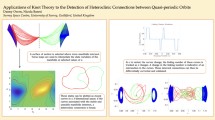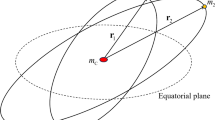Abstract
In this work we are interested in the central configurations of the planar \(1+4\) body problem where the satellites have different infinitesimal masses and two of them are diametrically opposite in a circle. We can think of this problem as a stacked central configuration too. We show that the configurations are necessarily symmetric and the other satellites have the same mass. Moreover we prove that the number of central configurations in this case is in general one, two or three and, in the special case where the satellites diametrically opposite have the same mass, we prove that the number of central configurations is one or two and give the exact value of the ratio of the masses that provides this bifurcation.


Similar content being viewed by others
References
Albouy, A., Fu, Y.: Relative equilibria of four identical satellites. Proc. R. Soc. Lond. Ser. A Math. Phys. Eng. Sci. 465, 2633–2645 (2009)
Casasayas, J., Llibre, J., Nunes, A.: Central configurations of the planar \(1+n\) body problem. Celest. Mech. Dyn. Astron. 60, 273–288 (1994)
Corbera, M., Cors, J., Llibre, J.: On the central configurations of the planar \(1+3\) body problem. Celest. Mech. Dyn. Astron. 109, 27–43 (2011)
Cors, J., Llibre, J., Ollé, M.: Central configurations of the planar coorbital satellite problem. Celest. Mech. Dyn. Astron. 89, 319–342 (2004)
Hagihara, Y.: Celestial mechanics, vol I: dynamical principles and transformation theory. The MIT Press, Cambridge (1970)
Hampton, M.: Stacked central configurations: new examples in the planar five-body problem. Nonlinearity 18, 2299–2304 (2005)
Maxwell, J.: On the stability of motion of Saturn’s rings. Macmillan & Co., London (1985)
Moeckel, R.: Relative equilibria with clusters of small masses. J. Dyn. Differ. Equ. 6, 507–533 (1997)
Oliveira, A., Cabral, H.: On stacked central configurations of the planar coorbital satellites problem. Discrete Contin. Dyn. Syst. 32, 3715–3732 (2012)
Renner, S., Sicardy, B.: Stationary configurations for co-orbital satellites with small arbitrary masses. Celest. Mech. Dyn. Astron. 88, 397–414 (2004)
Saari, D.: On the role and the properties of \(n\)-body central configurations. Celest. Mech. 21, 9–20 (1980)
Saari, D.: Collisions, rings, and other Newtonian \(N\)-body problems. CBMS regional conference series in mathematics, 104, American Mathematical Society (2005)
Wintner, A.: The analytical foundations of celestial mechanics. Princeton University Press, Princeton 1–43 (1941)
Author information
Authors and Affiliations
Corresponding author
Rights and permissions
About this article
Cite this article
Oliveira, A. Symmetry, bifurcation and stacking of the central configurations of the planar \(1+4\) body problem. Celest Mech Dyn Astr 116, 11–20 (2013). https://doi.org/10.1007/s10569-013-9472-0
Received:
Revised:
Accepted:
Published:
Issue Date:
DOI: https://doi.org/10.1007/s10569-013-9472-0




